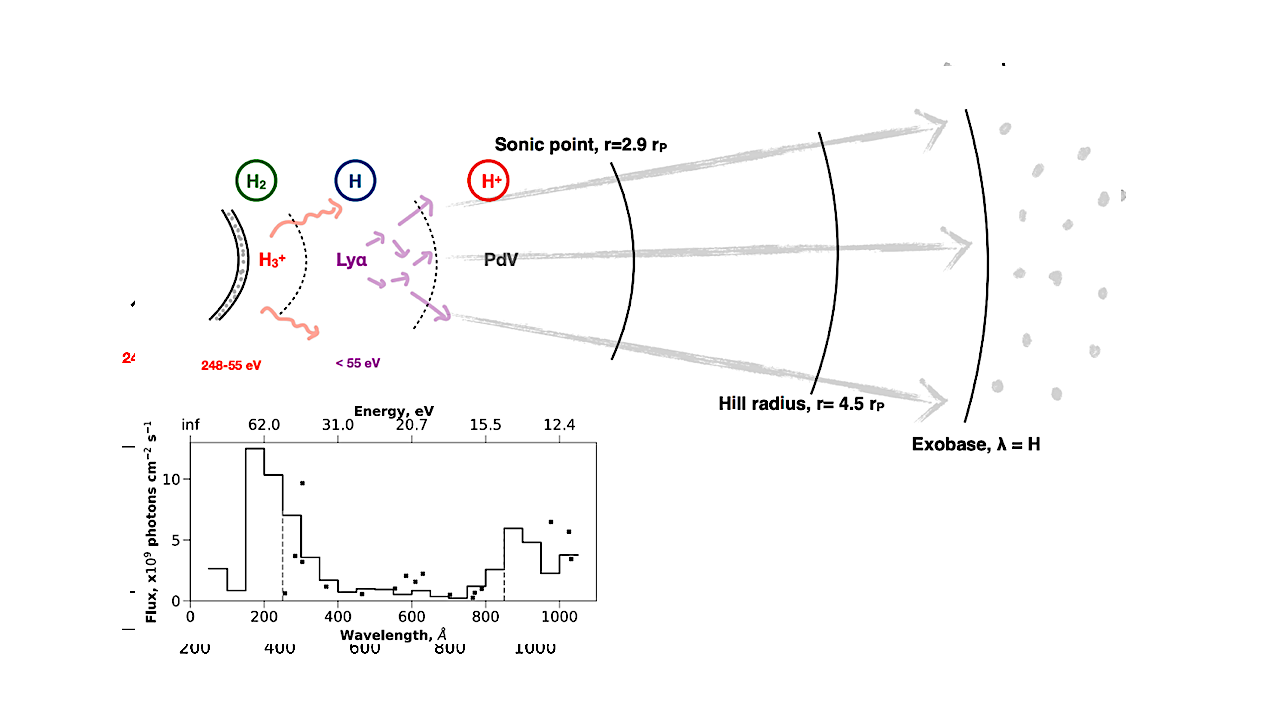Science
New Model Reveals Atmospheric Escape Mechanisms on Hot Jupiters

A recent study has introduced a comprehensive model that analyzes the atmospheric escape of hydrogen and helium on hot Jupiters, which are gas giants located close to their stars. Conducted by researchers Renata Frelikh and Ruth A. Murray-Clay, the study utilizes a one-dimensional code that simulates the effects of extreme-ultraviolet (EUV) radiation on these exoplanets.
The researchers have developed a model that accounts for several critical factors, including stellar spectrum heating, ionization, and radiative cooling processes. Their findings reveal a complex three-layer structure in the atmosphere of a typical hot Jupiter. At the base lies an H+3-cooled layer consisting of molecular hydrogen, surrounded by a Lyman-α-cooled layer of neutral hydrogen, which ultimately transitions into an ionized wind layer that cools through adiabatic expansion.
The study highlights that the most energetic photons from the star are primarily absorbed in the molecular layer. Here, the cooling effect of H+3 becomes significant, as it serves as a critical radiative coolant following energy loss due to ionization and photoelectrons.
Model Variations and Implications
Frelikh and Murray-Clay conducted a series of simulations to assess how varying distances from the host star impact atmospheric dynamics. Notably, they found that heat conduction effects begin to manifest at distances greater than or equal to 0.2 astronomical units (au). As the distance from the star increases, the outflow of atmospheric gases becomes more neutral, leading to a decoupling of neutral hydrogen from the ionized outflow, allowing it to escape more freely.
In simulations of pure H-He mini-Neptune and super-Earth atmospheres, the researchers observed significantly cooler outflows. This suggests that molecular cooling plays a crucial role in the potential for these planets to retain substantial atmospheres. The findings underline the importance of radiative cooling mechanisms in shaping the atmospheric escape processes on these distant worlds.
The analysis presented in this paper provides a valuable framework for understanding how molecular interactions influence atmospheric behavior. By integrating factors such as heating, cooling, and ionization, the research sheds light on the complexities of atmospheric dynamics in hot Jupiters and super-Earths.
The paper, accepted for publication in the Astrophysical Journal, spans 44 pages and includes 23 figures illustrating the model’s findings. This work contributes significantly to the field of Earth and planetary astrophysics, particularly in the context of understanding exoplanet atmospheres and their stability.
For further insights and details, the full study is available at arXiv:2511.15787.
-

 Technology4 months ago
Technology4 months agoDiscover the Top 10 Calorie Counting Apps of 2025
-

 Health2 months ago
Health2 months agoBella Hadid Shares Health Update After Treatment for Lyme Disease
-

 Health3 months ago
Health3 months agoErin Bates Shares Recovery Update Following Sepsis Complications
-

 Technology4 weeks ago
Technology4 weeks agoDiscover 2025’s Top GPUs for Exceptional 4K Gaming Performance
-

 Technology2 months ago
Technology2 months agoElectric Moto Influencer Surronster Arrested in Tijuana
-

 Technology4 months ago
Technology4 months agoDiscover How to Reverse Image Search Using ChatGPT Effortlessly
-

 Technology5 months ago
Technology5 months agoMeta Initiates $60B AI Data Center Expansion, Starting in Ohio
-

 Technology4 months ago
Technology4 months agoRecovering a Suspended TikTok Account: A Step-by-Step Guide
-

 Health4 months ago
Health4 months agoTested: Rab Firewall Mountain Jacket Survives Harsh Conditions
-

 Lifestyle4 months ago
Lifestyle4 months agoBelton Family Reunites After Daughter Survives Hill Country Floods
-

 Technology3 months ago
Technology3 months agoUncovering the Top Five Most Challenging Motorcycles to Ride
-

 Technology4 months ago
Technology4 months agoHarmonic Launches AI Chatbot App to Transform Mathematical Reasoning









